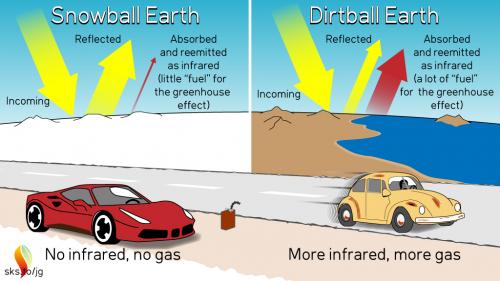
This is an updated version of Analogy 2. The original version is here.
A Ferrari without fuel goes nowhere.
Greenhouse gases without infrared radiation cause no warming.
Just as gasoline is the fuel that drives an engine, infrared radiation is the fuel that drives the greenhouse effect.
CO2 does not cause warming all on its own! If it did, then a cylinder of CO2 gas used to carbonate beverages would spontaneously heat up and explode. CO2 only causes warming in the presence of infrared radiation. More infrared radiation causes more warming.
Global warming occurs because infrared radiation emitted from the surface of the Earth is captured by greenhouse gases in the atmosphere, increasing the temperature of the atmosphere. Increasing either greenhouse-gas concentrations or the amount of infrared radiation increases global warming. Increasing both greenhouse gas concentrations and infrared radiation levels increases global warming even more. This is happening in the Arctic as reflective snow and ice melt, exposing dark oceans that absorb solar radiation and re-emit it as infrared radiation. As larger areas are converted from reflective snow and ice to absorbing water, the amount of sunlight absorbed increases, which increases the amount of infrared radiation emitted, which increases the local amount of warming. This is why the Arctic is warming faster than most other places on Earth.
Some skeptics point to Snowball Earth2 to “prove” that CO2 does not cause warming, by noting that 650 million years ago CO2 concentrations exceeded 1000 ppm (current CO2 concentrations are below 500 ppm), yet the world was frozen down to the equator. Part of what allowed Snowball Earth to occur was that solar radiation was 4% lower than today. A major reason that Snowball Earth persisted for so long is that snow and ice reflect 90% of incoming solar radiation. With much less solar radiation absorbed, there was much less infrared radiation emitted than before Snowball Earth occurred. The highly-reflective snow and ice reduced infrared radiation to the point that the greenhouse effect was severely reduced, allowing Snowball Earth to persist for a long time.3

Figure 1.Comparison of reflected sunlight and infrared radiation generation for Snowball and Dirtball Earth conditions.
The implications by some skeptics is that because CO2 levels exceeded 1000 ppm during Snowball Earth (i.e., during a global ice age), that CO2 does not cause warming. Such arguments fail to consider that global warming requires two actors: infrared radiation to provide the heat, and greenhouse gases to catch and trap the heat. Without one or the other there is no warming, kind of like a Ferrari with a big engine that goes nowhere without fuel in the tank. During Snowball Earth the infrared radiation needed to fuel the greenhouse effect was reduced enough to allow Snowball Earth to persist, despite the high CO2 levels.
Skeptics also fail to note what happened after the ice melted and Earth exited the Snowball Earth condition. Once the ice melted, exposing land that absorbed energy from sun light and re-emitting it as infrared radiation, all of the greenhouse gases that had accumulated in the atmosphere during the Snowball period began to rapidly warm the Earth. Even with 4% lower solar radiation than today, high greenhouse-gas concentrations + infrared radiation caused rapid warming, leaving little ice anywhere on Earth. If you're skeptical that Earth could warm enough to melt all the ice in the Arctic, consider the conditions that would have to exist to cause modern oil companies to try drilling for oil in the Arctic.
Today we have 4% higher solar radiation than during Snowball Earth. If CO2 concentrations exceed 1000 ppm in this century or the next, because we now have higher solar radiation than during Snowball Earth, the climate we would experience would be more like the Hothouse climate of the Eocene. (for additional reading see a study published in Nature Communications and summarized in this SkS posting).
Under these conditions alligators and crocodiles would likely once again be at home in the Arctic.
1. Whereas higher radiation level lead to a stronger greenhouse effect, more gasoline in the tank of a car does not lead to more power. In this sense the analogy does not quite follow the actual behavior of the greenhouse effect. The main point is that just as a car only operates by having both an engine and fuel, the greenhouse effect only operates by having both greenhouse gases and infrared radiation.
2. A period about 650 million years ago when ice or ice-slush covered most of Earth.
3. As you might guess, the complete physics that allowed Snowball Earth to occur and the factors that ended Snowball Earth are more complicated than what is described here. The main point of this analogy is to note that global warming relies on more than simply having arbitrarily high greenhouse-gas levels: infrared radiation is the other important player. For more information see the following article on the role of CO2 throughout the ages.
Posted by Evan on Tuesday, 8 March, 2022
 |
The Skeptical Science website by Skeptical Science is licensed under a Creative Commons Attribution 3.0 Unported License. |